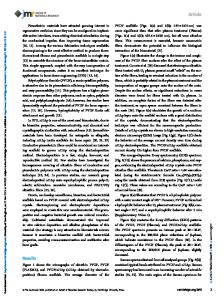Fabrication of piezoelectric nanogenerator based on P(VDF-HFP) electrospun nanofiber mat-impregnated lead-free BCZT nano
- PDF / 1,757,974 Bytes
- 12 Pages / 595.276 x 790.866 pts Page_size
- 54 Downloads / 353 Views
Fabrication of piezoelectric nanogenerator based on P(VDF-HFP) electrospun nanofiber mat-impregnated lead-free BCZT nanofillers Gun Anit Kaur1, Sahil Kumar1, and Mamta Shandilya1,* 1
School of Physics and Materials Science, Shoolini University, Solan, HP 173229, India
Received: 29 July 2020
ABSTRACT
Accepted: 24 September 2020
The replacement of energy harvesters by flexible, bendable, and environmentally benign materials could result in a significant breakthrough in wearable and portable electronics. In this context, polymeric nanocomposites consisting of organic polymer and inorganic nanoparticles are considered as suitable candidates that demonstrate enhanced performance as compared to their unmodified pristine polymeric counterparts. Herein, lead-free Ba0.85Ca0.15Zr0.05Ti0.95 (BCZT) nanoparticles were prepared by using the hydrothermal method and were impregnated within polymer matrix P(VDF-HFP) (poly(vinylidene fluoride-cohexafluoropropylene) via electrospinning to enhance the electroactive b-phase. XRD peak profile analysis and FTIR spectrum signify the strong emergence of electroactive b-phase. The electrospun BCZT/P(VDF-HFP) nanofiber mat exhibits higher b-phase fraction of 70.3% as compared to pristine electrospun P(VDF-HFP) nanofiber mat which can be ascribed to the presence of interfacial interactions at the interface of inorganic nanoparticle surface and the dipoles of P(VDF-HFP) inducing the electroactive b-phase. The fabricated piezoelectric nanogenerator BCZT/P(VDF-HFP) exhibited an output voltage of 2.5 V which is much higher than that of pristine P(VDF-HFP) (1.0 V) due to in situ alignment of BCZT nanoparticles and higher b-phase fraction.
Ó
Springer Science+Business
Media, LLC, part of Springer Nature 2020
1 Introduction Organic piezoelectric polymers such as polyvinylidene fluoride (PVDF) and its copolymers [P(VDFHFP), P(VDF-TrFE)] are being intensively explored by various researchers for energy-harvesting applications due to its flexibility, biocompatibility, and high elasticity [1, 2]. It exhibits five different
crystalline phases (a, b, c, d, and e) where both a- and d-phase are known as the non-polar phase and b-, c-, and e-phase are known as polar phases. Among these phases, polar b-phase possesses highest permanent dipole moment which is responsible for the enhanced electrical properties [3]. In addition, several parameters like solvent, melt temperature, stretching of thin films, and most importantly method of casting or
Address correspondence to E-mail: [email protected]; [email protected]
https://doi.org/10.1007/s10854-020-04550-w
J Mater Sci: Mater Electron
preparation play a vital role to achieve its desirable phase [4, 5]. However, traditional methods involve the fabrication of thin film counterparts by using spin coating [6], solution casting [7], solvent evaporation process [8], ultrasonication probe process [9], tape casting and hot pressing [10], and laser-lift off (LLO) process [11], which leads to undesirable non-polar phase formation and gen
Data Loading...











